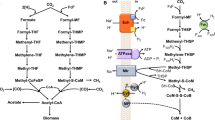Abstract
Cell suspensions of Acetobacterium woodii produced CO from H2 and CO2. Depending on the conditions, more than 1,000 ppm CO were measured in the gas phase. This concentration was more than 10-fold higher than the thermodynamic equilibrium concentration that can be calculated to be 83.5 ppm for the experimental conditions used. This finding is taken as evidence that, besides the activation of formate, also CO production from CO2 is an energy-dependent step in the reduction of CO2 to acetate. Studies on the influence of ionophores and dicyclohexylcarbodiimide (DCCD) as well as that of CO and formaldehyde on acetate synthesis were undertaken in order to determine whether ATP or \(\Delta \tilde \mu _H \) is the driving for CO2 reduction to CO.
Cells of A. woodii also catalyzed the conversion of CO (5% in the gas phase) to CO2 and H2. This process was coupled to the generation of metabolic energy, which could be used by the cells to drive the uptake of histidine into the cells; histidine uptake was almost completely inhibited by the ionophores valinomycin plus nigericin. The data were taken to indicate that in this acetogen the energy derived from CO oxidation can be converted to metabolic energy.
Similar content being viewed by others
Abbreviations
- DCCD:
-
dicyclohexylcarbodiimide
- THF:
-
tetrahydrofolate
- TCS:
-
tetrachlorosalicylanilide
- TPP+ :
-
tetraphenylphosphonium ion
- Val:
-
valinomycin; Nig, nigericin
- DTT:
-
dithiothreitol
- DTE:
-
dithioerythritol
- DTE:
-
dithioerythritol
- Δψ:
-
membrane potential
- \(\Delta \tilde \mu _H \) :
-
electrochemical proton potential
- ppm:
-
parts per million
References
Bott MH, Eikmanns B, Thauer RK (1985) Defective formation and/or utilization of carbon monoxide in H2/CO2 fermenting methanogens dependent on acetate as carbon source. Arch Microbiol 143:266–269
Diekert G, Ritter M (1982) Nickel requirement of Acetobacterium woodii J Bacteriol 151:1043–1045
Diekert G, Ritter M (1983) Carbon monoxide fixation into the carboxyl group of acetate during growth of Acetobacterium woodii on H2 and CO2. FEMS Microbiol Lett 17:299–302
Diekert G, Hansch M, Conrad R (1984) Acetate synthesis from 2 CO2 in acetogenic bacteria: is carbon monoxide an intermediate? Arch Microbiol 138:224–228
Diekert G, Fuchs G, Thauer RK (1985) Properties and function of carbon monoxide dehydrogenase from anaerobic bacteria. In: Poole RK, Dow CS (eds) Microbiol gas metabolism. Academic Press, London Orlando San Diego New York Toronto Montreal Sydney Tokyo, pp 115–130
Dorn M, Andreesen JR, Gottschalk G (1978) Fumarate reductase of Clostridium formicoaceticum. Arch Microbiol 119:7–11
Eden G, Fuchs G (1982) Total synthesis of acetyl coenzyme A involved in autotrophic CO2 fixation in Acetobacterium woodii. Arch Microbiol 133:66–74
Eikmanns B, Fuchs G, Thauer RK (1985) Formation of carbon monoxide from CO2 and H2 by Methanobacterium thermoautotrophicum. Eur J Biochem 146:149–154
Ghambeer RK, Wood HG, Schulman M, Ljungdahl L (1971) Total synthesis of acetate from CO2. III. Inhibition by alkylhalides of the synthesis from CO2, methyltetrahydrofolate, and methyl-B12 by Clostridium thermoaceticum. Arch Biochem Biophys 143:471–484
Harold FM (1977) Membranes and energy transduction in bacteria. Curr Top Bioenerg 6:83–149
Hu S-I, Drake HL, Wood HG, (1982) Synthesis of acetyl coenzyme A from carbon monoxide, methyltetrahydrofolate, and coenzyme A by enzymes from Clostridium thermoaceticum. J Bacteriol 149:440–448
Konings WN, Michels PAM (1980) Electron-transfer-driven solute translocation across bacterial membranes. In: Knowles CJ (ed) Diversity of bacterial respiratory systems, vol I. CRC Press Inc, Boca Raton, Florida, pp 3–86
Lorowitz WH, Bryant MP (1984) Peptostreptococcus productus strain that grows rapidly with CO as the energy source. Appl Environ Microbiol 47:961–964
Martin DR, Misra A, Drake HL (1985) Dissimilation of carbon monoxide to acetic acid by glucose-limited cultures of Clostridium thermoaceticum. Appl Environ Microbiol 49:1412–1417
Ragsdale SW, Wood HG (1985) Acetate biosynthesis by acetogenic bacteria. Evidence that carbon monoxide dehydrogenase is the condensing enzyme that catalyzes the final steps of the synthesis. J Biol Chem 260:3970–3977
Rottenberg H (1979) The measurement of membrane potential and ΔpH in cells, organelles, and vesicles. Methods in enzymology, vol LV, 547–569
Rühlemann M, Ziegler K, Stupperich E, Fuchs G (1985) Detection of acetyl coenzyme A as an early CO2 assimilation intermediate in Methanobacterium. Arch Microbiol 141:399–406
Schönheit P, Perski HJ (1983) ATP synthesis driven by a potassium diffusion potential in Methanobacterium thermoautotrophicum is stimulated by sodium. FEMS Microbiol Lett 20:263–267
Wood HG (1985) Then and now. Ann Rev Biochem 54:1–41
Zeikus JG, Kerby R, Krzycki JA (1985) Single-carbon chemistry of acetogenic and methanogenic bacteria. Science 227:1167–1173
Author information
Authors and Affiliations
Rights and permissions
About this article
Cite this article
Diekert, G., Schrader, E. & Harder, W. Energetics of CO formation and CO oxidation in cell suspensions of Acetobacterium woodii . Arch. Microbiol. 144, 386–392 (1986). https://doi.org/10.1007/BF00409889
Received:
Accepted:
Issue Date:
DOI: https://doi.org/10.1007/BF00409889




